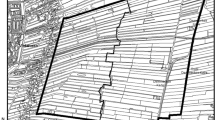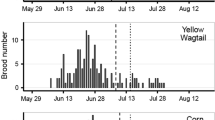Abstract
The increasing intensity of farming of meadows is supposed to be the major cause for strong declines of many meadow breeding birds. The whinchat, Saxicola rubetra, a Palaearctic migratory bird, is an indicator species of open grassland farmed at a low intensity. Originally widespread throughout Switzerland, it is now restricted to mountain and subalpine grassland. We document the changes in meadow cultivation in subalpine farmland from 1988 to 2002, and the breeding performance and density of the whinchat. We explored the impact of habitat degradation on the population dynamics of this meadow bird. The cultivation of hay meadows changed markedly within the 15 years: the onset of mowing was shifted forward by about 20 days, and farmers applied new techniques such as silage and irrigation. This shift was more pronounced in the favourable farmland in the valley bottom (Pradellas) than on the slopes (Vnà). The percentage of successful whinchat broods, ranging from 5% to 78% in different years, strongly depended on mowing date on both sites. In spite of earlier mowing, birds did not change their time schedule of breeding. Breeding success in Pradellas was too low to compensate for mortality (sink population), but because of immigration the number of breeding pairs did not decrease untill 2000. Population size may therefore be a misleading indicator of local population viability. Based on the breeding schedule of whinchats at different altitudes, we recommend mowing dates in agreement with the reproductive cycle of ground nesting meadow birds.




Similar content being viewed by others
References
Ackermann L (1999) Suivi d’une population de Tarier des prés (Saxicola rubetra) dans la haute vallée de la Doller (Haut-Rhin). Ciconia 23:81–100
Basore NS, Best LB, Wooley JB Jr (1986) Birds nesting in Iowa notillage and tilled cropland. J Wildlife Manage 50:19–28
Bastian A, Bastian HV (1996) Das Braunkehlchen: Opfer der ausgeräumten Kulturlandschaft. Aula, Wiesbaden
Beintema AJ, Müskens GJDM (1987) Nesting success of birds breeding in Dutch agricultural grasslands. J Appl Ecol 24:743–758
Best LB (1986) Conservation tillage: ecological traps for nesting birds? Wildlife Soc Bull 14:308–317
Bezzel E, Stiel K (1977) Zur Biologie des Braunkehlchens Saxicola rubetra in den Bayerischen Alpen. Anz Ornithol Ges Bayern 16:1–9
Bibby CJ, Burgess ND, Hill DA (1992) Bird census techniques. Academic Press, London
Blondel J, Perret P, Maistre M, Dias PC (1992) Do harlequin mediterranean environments function as a source sink for blue tits (Parus caeruleus L.)? Landscape Ecol 6:213–219
Boddy M (1993) Whitethroat Sylvia communis population studies during 1981–1991 at a breeding site on the Lincolnshire coast. Ringing Migration 14:73–83
Boddy M (1994) Survival/return rates and juvenile dispersal in an increasing population of lesser whitethroats Sylvia curruca. Ringing Migration 15:65–78
Boughton DA (1999) Empirical evidence for complex source-sink dynamics with alternative states in a butterfly metapopulation. Ecology 90:2727–2739
Bradbury RB, Kyrkos A, Morris AJ, Clark SC, Perkins AJ, Wilson JD (2000) Habitat associations and breeding success of yellowhammers on lowland farmland. J Appl Ecol 37:789–805
Brawn JD, Robinson SK (1996) Source-sink population dynamics may complicate the interpretation of long-term census data. Ecology 77:3–12
Brickle NW, Harper DGC, Aebischer NJ, Cockayne SH (2000) Effects of agricultural intensification on the breeding success of corn buntings Miliaria calandra. J Appl Ecol 37:742–755
Burnham KP, Anderson DR (1998) Model selection and inference: a practical information-theoretic approach. Springer, New York Berlin Heidelberg
Chamberlain DE, Crick HQP (1999) Population declines and reproductive performance of skylarks Alauda arvensis in different regions and habitats of the United Kingdom. Ibis 141:38–51
Choquet R, Reboulet A-M, Pradel R, Lebreton J-D (2001) U-CARE (Utilities—capture-recapture) user’s guide. Typoscript. CEFE/CNRS, Montpellier
Delibes M, Ferrera P, Gaona P (2001) Attractive sinks, or how individual behavioural decisions determine source-sink dynamics. Ecol Lett 4:401–403
Di Giulio M, Edwards PJ, Meister E (2001) Enhancing insect diversity in agricultural grasslands: the roles of management and landscape structure. J Appl Ecol 38:310–319
Dias PC (1996) Sources and sinks in population biology. Trends Ecol Evol 11:326–330
Dias PC, Blondel J (1996) Local specialization and maladaptation in the Mediterranean blue tit (Parus caeruleus). Oecologia 107:79–86
Diffendorfer JE (1998) Testing models of source-sink dynamics and balanced dispersal. Oikos 81:417–433
Donovan TM, Lamberson RH, Kimber A, Thompson FR III, Faaborg J (1995) Modeling the effects of habitat fragmentation on source and sink demography of Neotropical migrant birds. Conserv Biol 9:1396–1407
Glutz von Blotzheim UN, Bauer KM (1988) Handbuch der Vögel Mitteleuropas. Passeriformes (2. Teil): Turdidae. Aula, Wiesbaden
Gundersen G, Johannesen E, Andreassen HP, Ims RA (2001) Source-sink dynamics: how sinks affect demography of sources. Ecol Lett 4:14–21
Hagemeijer EJM, Blair MJ (1997) The EBCC Atlas of European breeding birds. Poyser, London
Klomp H (1954) Habitat selection in the lapwing Vanellus vanellus (L.). Ardea 42:1–139
Labhardt A (1984) Biometrie des Braunkehlchens Saxicola rubetra: variationen in den Flügelmassen und im Körpergewicht zur Brutzeit. Ornithol Beob 81:233–247
Labhardt A (1988) Siedlungsstruktur von Braunkehlchen-Populationen auf zwei Höhenstufen der Westschweizer Voralpen. Beih Veröffentlich Naturschutz Landschaftspfl Baden-Württemberg 51:139–158
Lawn MR (1994) Site fidelity and annual survival of territorial male Willow Warblers Phylloscopus trochilus at four adjacent sites in Surrey. Ringing Migration 15:1–7
Lebreton JD, Burnham KP, Clobert J, Anderson DR (1992) Modeling survival and testing biological hypothesis using marked animals: a unified approach with case studies. Ecol Monogr 62:67–118
Luder R (1981) Die Avifauna der Gemeinde Lenk. Ornithol Beob 78:193–208
Manuel F, Beaud P (1982) L’installation de silos à herbe et ses répercussions sur un échantillonnage de Traquet tariers, Saxicola rubetra, nicheurs du Pays d’Enhaut. Nos Oiseaux 36:277–281
Müller M (1996) Das Engadin: Lebensraum für Brutvögel der offenen und halboffenen Kulturlandschaft. Jahresber Naturforsch Ges Graubünden 108:39–119
Peach WJ, Thompson PS, Coulson JC (1994) Annual and long-term variation in the survival rates of British lapwings Vanellus vanellus. J Anim Ecol 63:60–70
Pulliam HR (1988) Sources, sinks, and population regulation. Am Nat 132:652–661
Pulliam HR (1996) Sources and sinks: empirical evidence and population consequences. Rhodes OEJ, Chesser RK, Smith MH (eds) Population dynamics in ecological space and time. University of Chicago Press, Chicago, pp 45–69
Pulliam HR, Danielson BJ (1991) Sources, sinks and habitat selection: a landscape perspective on population dynamics. Am Nat 137:S50–S66
Remeš V (2000) How can maladaptive habitat choice generate source-sink population dynamics. Oikos 91:579–582
Schifferli L (2000) Changes in agriculture and the status of birds breeding in European farmland. In: Aebischer NJ, Evans AD, Grice PV, Vickery JA (eds) Ecology and conservation of lowland farmland birds. Proceedings of the British Ornithologist’s Union conference 1999. British Ornithologist’s Union, Tring, pp 17–25
Schifferli L, Fuller RJ, Müller M (1999) Distribution and habitat use of bird species breeding on Swiss farmland in relation to agricultural intensification. Vogelwelt 120[Suppl]:151–161
Schmid H, Feller V, Blaser P (1994) Hat das Braunkehlchen Saxicola rubetra als Wiesenbrüter im Berner Oberland noch eine Chance? Mitteilungen der Naturwissenschaftlichen Gesellschaft Thun, H. 12:109–120
Schmid H, Luder R, Naef-Daenzer B, Graf R, Zbinden N (1998) Schweizer Brutvogelatlas. Verbreitung der Brutvögel in der Schweiz und im Fürstentum Liechtenstein 1993–1996. Schweizerische Vogelwarte, Sempach
Schmidt K, Hantge E (1954) Studien an einer farbig beringten Population des Braunkehlchens (Saxicola rubetra). J Ornithol 95:130–173
Schwaiger H, Burbach K (1998) Landesweite Wiesenbrüterkartierung in Bayern 1998. Bayerisches Landesamt für Umweltschutz, Freising
Siriwardena GM, Baillie SR, Wilson JD (1998) Variation in the survival rates of some British passerines with respect to their population trends on farmland. Bird Study 45:276–292
Svensson L (1984) Identification guide to European passerines. Lars Svensson, Stockholm
Thomas CD, Kunin WE (1999) The spatial structure of populations. J Anim Ecol 68:647–657
Tucker GM, Heath MF (1994) Birds in Europe: their conservation status. BirdLife International, Cambridge
Uhl H (1996) Braunkehlchen in Oberösterreich oder vom unauffälligen Sterben eines bunten Vogels. Öko L 18:15–25
Van Horne B (1983) Density as a misleading indicator of habitat quality. J Wildlife Manage 47:893–901
Watkinson AR, Sutherland WJ (1995) Sources, sinks and pseudo-sinks. J Anim Ecol 64:126–130
White GC, Burnham KP (1999) Program MARK: survival estimation from populations of marked animals. Bird Study 46[Suppl]:120–139
Yeatman-Berthelot D, Jarry G (1994) Nouvel atlas des oiseaux nicheurs de France 1985–1989. Société Ornithologique de France, Paris
Acknowledgements
We thank the late M. Leuenberger, R. Wüst, P. Lustenberger and R. Pfüller for their field assistance. M. Schaub helped with the statistical analyses of survival rates. World Wildlife Found Switzerland, Pro Natura Switzerland, BirdLife Switzerland, Karl-Mayer foundation, Däniker foundation, and the Animal Protection Society of the canton Zurich supported the field study in the Engadine in 1987 and 1988.
Author information
Authors and Affiliations
Corresponding author
Rights and permissions
About this article
Cite this article
Müller, M., Spaar, R., Schifferli, L. et al. Effects of changes in farming of subalpine meadows on a grassland bird, the whinchat (Saxicola rubetra). J Ornithol 146, 14–23 (2005). https://doi.org/10.1007/s10336-004-0059-0
Received:
Revised:
Accepted:
Published:
Issue Date:
DOI: https://doi.org/10.1007/s10336-004-0059-0




